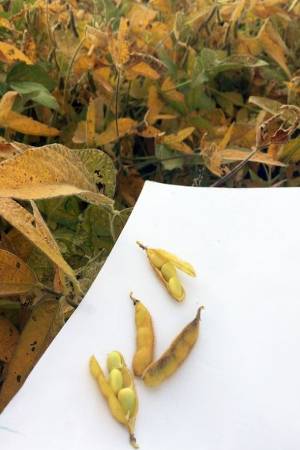By Lyndon Kelley

Soybeans need at least 50% soil moisture through growth stage R-6 or until at least one pod on 50% of the plants has reached its mature color.
The low August 2020 rainfall in Michiana had many fields exhibiting drought conditions. The United States Drought Monitor has shown Northcentral and Northeast Indiana in the abnormally dry category from mid-July through August. The Michigan State University Enviroweather stations at Cass, Kalamazoo and St. Joseph counties all show greater than 55% rainfall deficit for July and August compared to the previous five-year average (Table 1). Low rainfall leads to the question, “When can I stop irrigating?”
Table 1. Rainfall totals from July 1 – Aug. 27, 2020, compared to previous five-year averages.
Turning off the irrigation too soon could lower corn and soybean yields or reduce test weight. However, irrigating beyond the crop’s water need wastes time, energy and money. Applying water when only needed (irrigation scheduling) is environmentally and economically important. MSU’s Soil Water Balance fact sheet shows corn from early dent to black layer lower it’s weekly water use from 1 to 0.5 inches and soybeans from full seed to mature pod will lower it’s weekly water use from 1.1 to 0.4 inches.
September rainfall in most years alleviates the late-season irrigation scheduling questions. The typical crop water usage drops quickly as average rainfall increases making late-season irrigation less important. However, many of the areas where crops were planted late may have substantial water needs well into September, signaling the need for some type of irrigation management either by a scheduling program or crop monitoring to determine timing and volume of irrigation application.
Try to minimize the number of applications needed to finish the crop. Large applications (0.8 to 1.1 inches) every six to eight days is more water-use efficient and has less potential to increase disease potential than more frequent smaller applications. The goal should be to provide enough water to avoid yield and quality loss but not leave much of the applied water left in the soil profile in the end.
Late-season crop water use (termed evapotranspiration, or ET) lowers significantly as the crop nears maturity. Soybean plants showing their first yellow pods will have an ET value of 0.09 inches per day for a day that reaches the mid-70s Fahrenheit. Corn at late dent stage will have an ET of 0.13 inches per day for a day that reaches the mid-70s. For both corn and soybeans, ET will be 0.02 inches less per day for days that warm up to only the mid-60s. Most years, early September conditions change to cooler wet weather where rainfall surpasses crop water use resulting in a quick end to the irrigation season.
Soybean irrigators should maintain at least 50% of the available soil water-holding capacity until most pods are light yellow. Corn producers trying to maintain test weight in dry, late-summer conditions should maintain at least 50% of the available soil water-holding capacity until the crop reaches black layer. In most situations, minimal amounts of water are needed to achieve these goals. In the last few weeks of the season, soybeans will use less than 0.04 inches per day and corn less than 0.06 inches per day, allowing a half-inch of rain or irrigation to last a week or more.
Probing soil at the center of the root mass is a simple irrigation scheduling method used to aid in late-season irrigation decisions. A soil auger probe from 12 inches below the surface in the root zone should still have moisture present as indicated by formation of a loose ball formed from sandy loam soil. Soils that form a tight ball show an even higher soil moisture level that could carry a crop for a few more days. Fact sheets and bulletins on estimating soil moisture by feel and irrigation scheduling are available from the MSU Extension Irrigation website.
Source : msu.edu